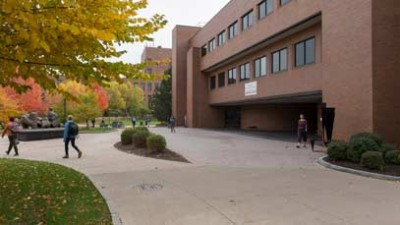Creating new sounds with instruments and technology
Discarded harpsichord finds new life in a class inside RIT’s SHED
Traci Westcott/RIT
Matias Homar, left, explains how a discarded harpsichord can make new sounds with help from sensors and microphones in his History and Technology of Musical Instruments class, which he taught this semester in the SHED.
Bach never heard his harpsichord make sounds like this.
Students in the History and Technology of Musical Instruments class taught by Matias Homar at Rochester Institute of Technology got the chance to take a discarded harpsichord and bring it to life, juicing it up with electricity, connecting it with a computer and monitors, and adding sensors, microphones, and even lights to it.
The project is among the first to be conducted in RIT’s new Student Hall for Exploration and Development (SHED). The $120 million facility has numerous maker spaces and encourages interdisciplinary collaboration.
“We had parts to hold wires in place made on the 3D printer downstairs, and could do our soldering in another room,” said Homar, a visiting assistant professor.
The hands-on class encourages students to seek new ways to merge technology with music. Liam Yost, a second-year chemical engineering major from Matamoras, Pa., stood at the harpsichord’s keyboard and began playing what sounded like a simple scale, which had been altered with an acoustical wah-wah pedal.
The students are also working on their own projects, creating or researching different instruments and technologies. Yost recorded notes he played on a baritone saxophone and is developing a program that can let him compose a tune selecting and placing those various notes on a computer.
Classmates Matt Boyle, a second-year student from Wilmington, Del., focusing on live esports production with broadcasting through RIT’s School of Individualized Study (SOIS), and Joel Pho, of Williamsburg, Va., a third-year SOIS student focusing on audio engineering, are working on a “beat maker.” The device is akin to a metronome, or it can be used as a miniature keyboard. It will allow the user to insert notes by pressing one of eight buttons that will play at a preprogrammed rate.
“I do enjoy making music, and this will help me do that going forward,” Boyle said. “I never played an instrument prior to this other than a recorder in elementary school.”
Boyle said he enjoyed learning how modern composers have used technology to break from the traditional, rigid music theory by experimenting with things like synthesizers that use voltage-controlled oscillators.
“We heard one abstract piece where the composer intentionally made it sound like something we’ve never heard before,” Boyle said. “This music room has really good speakers, and you can really hear the differences.”
He also said he planned to use a nearby 3D printer in the SHED to build the case for his project.
Blake Donley, a fifth-year computer engineering major from Thousand Oaks, Calif., and his classmate, Patrick Philippy, a fourth-year computer science major from Churchville, N.Y., are working on a project that will create music based on hand gestures.
“We’re using gesture recognition,” Philippy said. “It works like a musical instrument. As the hand shape changes, the music changes.”
Whether or not these classroom creations become the next musical craze isn’t as important as stimulating students’ creativity, Homar said.
“My goal is that the students will be able to use an artistic approach to solve practical situations they usually find in their own fields of expertise,” he said. “This class was intended to contribute to the development of the students’ creative minds when facing daily challenges in their jobs and lives.”






